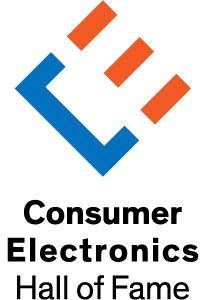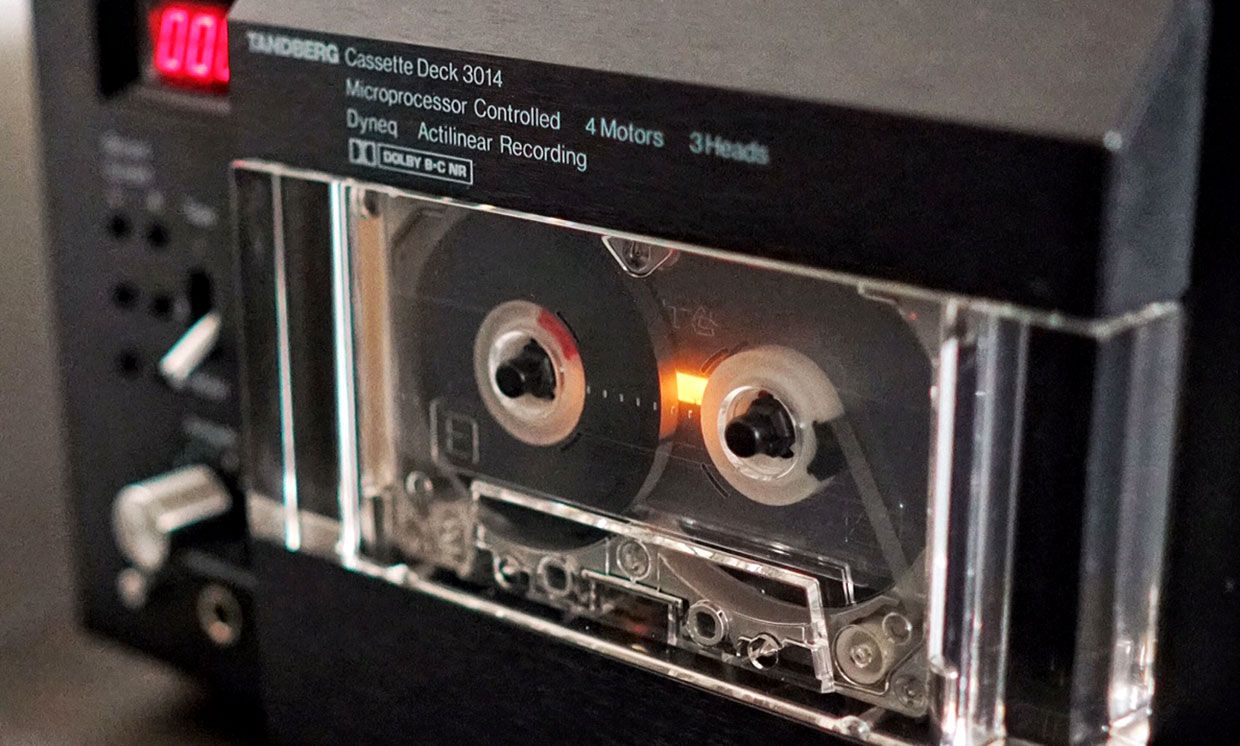The Consumer Electronics Hall of Fame: Tandberg TCD 3014 Tape Deck
 Photo: AudioCirc St. George Redux: Introduced in 1984, the Tandberg TCD 3014 tape deck earned the nickname "Dragon slayer" because it was designed to take on the Nakamichi Dragon, the most advanced tape deck in the world at the time.
Photo: AudioCirc St. George Redux: Introduced in 1984, the Tandberg TCD 3014 tape deck earned the nickname "Dragon slayer" because it was designed to take on the Nakamichi Dragon, the most advanced tape deck in the world at the time.  Enter Here < Back to Consumer Electronics Hall of Fame
Enter Here < Back to Consumer Electronics Hall of Fame Once upon a time, there was a Dragon, and yea, verily, this Dragon dominated all the land, and thus it was, 'til one day appeared"the Dragon slayer.
No, we're not getting all "Game of Thrones" on you. We're talking about the most highly regarded compact-cassette tape decks ever produced.
Starting in the mid-1970s and continuing into the 1980s, Nakamichi Corp. dominated the market for high-end cassette players. In 1983, the company introduced the Dragon, the first in a line that would share the name. That first Dragon set a new standard for high-performance tape decks. The Norwegian company Tandberg responded one year later with the TCD 3014, a beast of a machine that was immediately hailed as the Dragon's equal, if not more than that-hence, the "Dragon slayer."
To understand the significance of this rivalry requires a bit of perspective on audiotape.
The Compact Cassette audiotape format was created in the early 1960s. In the 1970s and through the early 1990s, cassettes were one of the two most popular media types in the world, sharing the distinction first with LPs and then with compact discs (CDs). LPs and reel-to-reel tapes were not portable, but cassettes were. A short-lived rival format, the 8-track tape, was sort of portable but clunky and of dubious fidelity. Cassettes, on the other hand, were convenient and (eventually) hi-fi. The combination made the Compact Cassette format a winner. The recordable cassette-tape format also popularized the mixtape, a cultural staple in the 1970s, 1980s, and 1990s. Although reel-to-reel owners invented the notion of putting a personal mix of songs on a tape, the practice didn't go mainstream until the 1970s, when cassette players became common stereo components.
 Photo: Bbadgett/Wikipedia Enter the Dragon: Nakamichi's legendary tape deck used a microprocessor to control the position of the tape on the read head.
Photo: Bbadgett/Wikipedia Enter the Dragon: Nakamichi's legendary tape deck used a microprocessor to control the position of the tape on the read head. But though they had convenience and recordability, what cassette tapes lacked, early on, was audio quality. Through the 1970s, cassette manufacturers devised a number of ways to improve the tape itself to achieve better audio performance, but regardless of the formulation of the recording medium, getting the very best possible sound out of a cassette deck also required very precise alignment of the cassette tape as it advanced over the read head, an electromagnetic device a little smaller than a sugar cube. Feeding the tape over the head at a consistent speed was also necessary for the best sound. In the late 1970s and early 1980s, Nakamichi earned a reputation for quality with several innovations to control the advancement of the tape and achieve superior alignment. The company employed a quartz clock to control the motors used to spool the tape. It also developed a scheme called Nakamichi Auto Azimuth Correction, which used a microprocessor to control the position of the tape on the servo-controlled read head and make adjustments to achieve optimal alignment.
Tandberg countered the Nakamichi Dragon's advances with its own innovations. To move the tape, the company's 3014 used four separate motors and incorporated dual flywheels to stabilize speed. Casual users could simply hit the play button and get great sound, but Tandberg also provided an option to physically adjust the position of the tape heads to customize the sound, a feature that appealed particularly to audiophiles.
In addition to all that, Tandberg developed two separate technologies to try to outdo its Japanese rival. One of those patented technologies was called Actilinear II, which minimized distortion. The other was called Dyneq, which helped with the reproduction of sound at higher frequencies.
Dyneq was a response to a limitation inherent in magnetic tape. Tape lacked the ability to fully reproduce loud, high frequency sounds-cymbals, for example, or the highest notes of a trumpet. Recording engineers knew they had to adjust accordingly. "Many a lusty fortissimo and trenchant sforzando therefore had to be taken down a few notches to make the music digestible for cassettes," a contemporary review of the 3014 in The New York Times noted.
The problem was tape hiss. Balancing highs against lows is a delicate act; trying to avoid distortion during highs risks emphasizing hiss during the lows, and vice versa. The balance can be adjusted during playback, however, through equalization. Equalization is typically a static process. Listeners can set which frequency ranges they wish to boost and/or suppress. Alternatively, manufacturers of players will sometimes offer different settings for rock, opera, jazz, and so on. These are essentially different preset configurations for equalization likely to be appropriate for each genre of music. Tandberg's breakthrough was figuring out how to continuously adjust equalization on the fly. It was dynamic equalization-hence the term Dyneq.
 Photo: AudioCirc Smooth Operator: Among the Tandberg deck's innovations was a dual-flywheel system that ensured that the speed of the tape over the read head was extremely stable.
Photo: AudioCirc Smooth Operator: Among the Tandberg deck's innovations was a dual-flywheel system that ensured that the speed of the tape over the read head was extremely stable. The superior sound of the new Tandberg cassette player earned it immediate accolades. "If one had to single out the best cassette deck, a leading candidate for this distinction would unquestionably be Tandberg's new Model TCD 3014," the New York Times review gushed. The 3014's tanklike construction was another selling point for some.
Tandberg followed the 3014 with the 3014A. Archival materials from Tandberg do not make much of the distinctions between the two. Owners of both models note that there were changes in some of the mechanical elements and say the circuit board was lightly reconfigured. Audiophiles swear the successor model was sonically superior, but they're mostly at a loss to say specifically why.
Though cassettes coexisted with CDs for a few years, cassettes were analog, and analog technologies were doomed to be overwhelmed by digital. The high mark for cassette tapes was around 1990, when 442 million prerecorded cassettes were sold, along with hundreds of millions of blank tapes. But the reign of digital media had already begun. Nakamichi was purchased in 1998 and went bankrupt in 2002 (the Chinese buyer later revived the brand name for a line of sound bars for TVs). Meanwhile, the various operations of Tandberg were split from each other, sold, and nearly all of them were eventually resold. The unit that built tape players is no more, though because the trail of corporate sales is murky it's hard to pinpoint where the tape deck unit went and when exactly it went away.
By 2013, music streaming was cutting deeply into sales of physical storage media. People have always fetishized vinyl LPs, however, and a little over a decade ago that lingering fervor helped spark a minor resurgence in record sales that still hasn't abated: Approximately 16.8 million LPs were sold in 2018 in the United States. Recently, sales of cassettes were also revived, partly as a side effect of the resurgent interest in LPs but mostly inspired by the mixtapes that Peter Quill/Star-Lord listens to in the Guardians of the Galaxy films. The nostalgia for cassettes exists, but it's nowhere near the enthusiasm for vinyl. In 2018, just over 200,000 prerecorded cassettes were sold in the United States.
Scour Internet message boards, however, and you'll still find people trying to find spare parts for their Dragons and Dragon slayers.
Back to Consumer Electronics Hall of Fame >> < Back to Consumer Electronics Hall of Fame